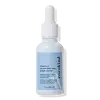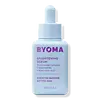What's inside
What's inside
 Key Ingredients
Key Ingredients

 Benefits
Benefits

 Concerns
Concerns

No concerns
 Ingredients Side-by-side
Ingredients Side-by-side

Aloe Barbadensis Leaf Juice
Skin ConditioningWater
Skin ConditioningGlycerin
HumectantPolyglycerin-6
HumectantPentylene Glycol
Skin ConditioningAscorbyl Glucoside
AntioxidantAzelaic Acid
BufferingPropanediol
SolventXanthan Gum
EmulsifyingCaprylyl Glyceryl Ether
CleansingSodium Hydroxide
BufferingSodium Citrate
BufferingBetaine
HumectantCaulerpa Lentillifera Extract
Caprylhydroxamic Acid
Sodium Hyaluronate
HumectantSodium Phytate
Sodium Benzoate
MaskingCitric Acid
BufferingAloe Barbadensis Leaf Juice, Water, Glycerin, Polyglycerin-6, Pentylene Glycol, Ascorbyl Glucoside, Azelaic Acid, Propanediol, Xanthan Gum, Caprylyl Glyceryl Ether, Sodium Hydroxide, Sodium Citrate, Betaine, Caulerpa Lentillifera Extract, Caprylhydroxamic Acid, Sodium Hyaluronate, Sodium Phytate, Sodium Benzoate, Citric Acid
Water
Skin ConditioningMethylpropanediol
SolventNiacinamide
Smoothing1,2-Hexanediol
Skin ConditioningGlycerin
HumectantPolyglyceryl-10 Laurate
Skin ConditioningSodium Hyaluronate
HumectantCeramide NP
Skin ConditioningCholesterol
EmollientCaprylic/Capric Triglyceride
MaskingPhytosphingosine
Skin ConditioningSodium Phytate
Ascorbic Acid
AntioxidantStearic Acid
CleansingOleic Acid
EmollientHydrogenated Lecithin
EmulsifyingEthylhexylglycerin
Skin ConditioningXanthan Gum
EmulsifyingSqualane
EmollientTocopherol
AntioxidantLactic Acid
BufferingCarbomer
Emulsion StabilisingTromethamine
BufferingCaprylyl Glycol
EmollientCaprylhydroxamic Acid
Water, Methylpropanediol, Niacinamide, 1,2-Hexanediol, Glycerin, Polyglyceryl-10 Laurate, Sodium Hyaluronate, Ceramide NP, Cholesterol, Caprylic/Capric Triglyceride, Phytosphingosine, Sodium Phytate, Ascorbic Acid, Stearic Acid, Oleic Acid, Hydrogenated Lecithin, Ethylhexylglycerin, Xanthan Gum, Squalane, Tocopherol, Lactic Acid, Carbomer, Tromethamine, Caprylyl Glycol, Caprylhydroxamic Acid
 Reviews
Reviews

Ingredients Explained
These ingredients are found in both products.
Ingredients higher up in an ingredient list are typically present in a larger amount.
Caprylhydroxamic Acid is a chelating agent.
Chelating agents help prevent metal ions from binding to other ingredients. This helps prevent unwanted reactions and effects from using the product.
Caprylhydroxamic Acid is often used with natural antimicrobial products as an alternative to preservatives.
Learn more about Caprylhydroxamic AcidGlycerin is already naturally found in your skin. It helps moisturize and protect your skin.
A study from 2016 found glycerin to be more effective as a humectant than AHAs and hyaluronic acid.
As a humectant, it helps the skin stay hydrated by pulling moisture to your skin. The low molecular weight of glycerin allows it to pull moisture into the deeper layers of your skin.
Hydrated skin improves your skin barrier; Your skin barrier helps protect against irritants and bacteria.
Glycerin has also been found to have antimicrobial and antiviral properties. Due to these properties, glycerin is often used in wound and burn treatments.
In cosmetics, glycerin is usually derived from plants such as soybean or palm. However, it can also be sourced from animals, such as tallow or animal fat.
This ingredient is organic, colorless, odorless, and non-toxic.
Glycerin is the name for this ingredient in American English. British English uses Glycerol/Glycerine.
Learn more about GlycerinSodium Hyaluronate is hyaluronic acid's salt form. It is commonly derived from the sodium salt of hyaluronic acid.
Like hyaluronic acid, it is great at holding water and acts as a humectant. This makes it a great skin hydrating ingredient.
Sodium Hyaluronate is naturally occurring in our bodies and is mostly found in eye fluid and joints.
These are some other common types of Hyaluronic Acid:
Learn more about Sodium HyaluronateSodium Phytate is the synthetic salt form of phytic acid. Phytic acid is an antioxidant and can be found in plant seeds.
Sodium Phytate is a chelating agent. Chelating agents help prevent metals from binding to water. This helps stabilize the ingredients and the product.
Water. It's the most common cosmetic ingredient of all. You'll usually see it at the top of ingredient lists, meaning that it makes up the largest part of the product.
So why is it so popular? Water most often acts as a solvent - this means that it helps dissolve other ingredients into the formulation.
You'll also recognize water as that liquid we all need to stay alive. If you see this, drink a glass of water. Stay hydrated!
Learn more about WaterXanthan gum is used as a stabilizer and thickener within cosmetic products. It helps give products a sticky, thick feeling - preventing them from being too runny.
On the technical side of things, xanthan gum is a polysaccharide - a combination consisting of multiple sugar molecules bonded together.
Xanthan gum is a pretty common and great ingredient. It is a natural, non-toxic, non-irritating ingredient that is also commonly used in food products.
Learn more about Xanthan Gum